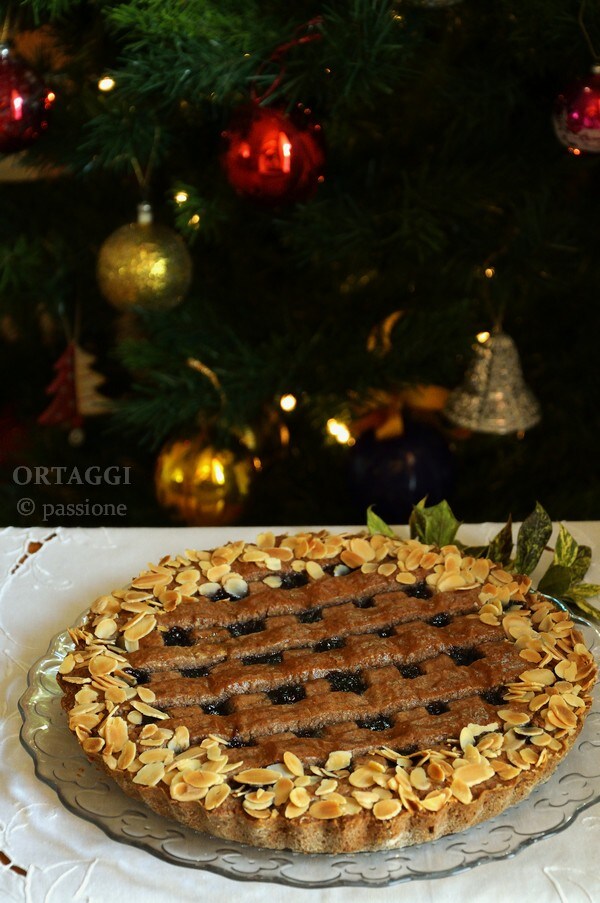The Linzer torte (or Linz tart) is a soft and fragrant dessert from Südtirol that will win you over with its flavor. A classic in Italian cuisine ideal for winter festivities in the Austrian and Tyrolean (Trentino Alto Adige) tradition. It is said that the Linzer Torte is one of the oldest sweet recipes in the world. The original recipe is made with buckwheat, while my modern version is the one passed down by Grandma Benedetta.
My Christmas Desserts

- Difficulty: Medium
- Cost: Medium
- Preparation time: 1 Hour
- Portions: for a 9.5 – 10 inch round pan
- Cooking methods: Oven
- Cuisine: Austrian
- Seasonality: Christmas
Linzer torte
- 2 1/4 cups all-purpose flour (and/or type 1 or whole wheat)
- 2/3 cup granulated sugar (and/or whole cane sugar)
- 1/2 cup butter
- 2 medium eggs
- 2 1/4 oz almonds and/or hazelnuts (chopped with or without skin)
- 2 tbsp unsweetened cocoa powder
- 1 tsp ground cinnamon (3 g)
- pinches ground cloves (use a mortar)
- nutmeg (freshly ground)
- lemon or orange (only if organic)
- baking powder
- 1 pinch salt
- 10 1/2 oz raspberry or lingonberry jam
- to taste sliced almonds
- egg white (optional)
Tools
- Tart pan 24 cm
Linzer torte
First, remove the butter from the refrigerator, then chop the almonds with a little sugar (taken from the total), alternatively use almond flour.
In a bowl, sift the flour, cocoa, cinnamon, and baking powder. Add the sugar, chopped almonds, a pinch of salt, the spices, and the finely chopped lemon zest. Then add the butter (at room temperature) cut into cubes, and pinch it together with the other ingredients until you get a sandy mixture.
Add the eggs and work everything until you get a rather soft dough. If it turns out too sticky, pour in a little more flour (don’t overdo it, a characteristic of Linzer torte is that its shortcrust pastry is very soft). Then form a ball, wrap it in plastic wrap, and let it rest in the refrigerator for a couple of hours (to speed up the process, you can put it in the freezer for about 30 minutes).
Assemble the Linzer Torte
On a lightly floured surface, roll out about half of the dough (to about 1/4 inch or more if you want it higher) with the help of a lightly floured rolling pin. Then place the rolled-out dough in a previously buttered round cake pan (9.5 – 10 inches) and create a border about 1/2 inch high to contain the filling of the Linzer torte.
Using the tines of a fork, prick the entire base of the pastry and then fill it with the jam. With the rest of the dough, form cords and arrange them in a lattice pattern over the jam (one of the characteristics of the Linzer torte is its very dense lattice).
Brush with an egg white (or a beaten whole egg) both the edge of the cake (it will serve as glue to attach the almonds) and the applied pastry strips (it will make the cake shinier). Finally, place almond slices along the entire edge of the cake or over its entire surface.
Bake in a preheated static oven at 356°F (180°C) for 35 minutes. Let it cool well before removing it to avoid disasters when the jam is still hot and soft.
Linzer Cookies (Linz Squares)
Linzer Schnitten, found in bakeries, are nothing but cookies of this fabulous cake. To make them at home, you just need to: increase the doses and make this cake in a square or rectangular mold and then cut it into slices or square pieces.
Linzer Schnitten, found in bakeries, are nothing but cookies of this fabulous cake. To make them at home, you just need to: increase the doses and make this cake in a square or rectangular mold and then cut it into slices or square pieces.
Linzer Schnitten, found in bakeries, are nothing but cookies of this fabulous cake. To make them at home, you just need to: increase the doses and make this cake in a square or rectangular mold and then cut it into slices or square pieces.
With this recipe, I am participating in the “Traditional Desserts” collection by AIFB.
Where to eat Linzer Torte?
The Linzer Torte is a traditional Austrian dessert consisting of a shortcrust pastry base filled with currant or raspberry jam, often decorated with a lattice of pastry on top. This dessert is delicious and can be found in many bakeries and cafes in Austria and some nearby regions. I recommend looking for traditional bakeries, cafes, or Austrian restaurants, especially in larger cities like Vienna, Salzburg, Innsbruck, and Graz.

